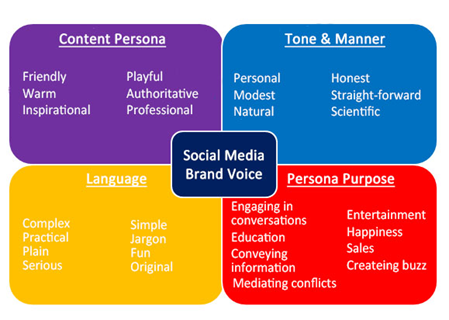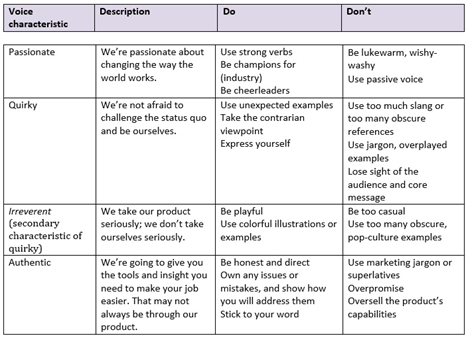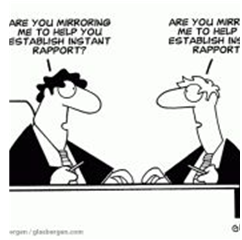Knowing how to properly communicate with your audience can make or break your business, regardless of how great your product or service is. Indeed, defining and creating your brand voice should be one of your first steps in developing your marketing strategy and plan.
Your brand’s voice is your company’s personality and mouth piece. It could be both the tone you address your clients or the style of writing you use in different marketing materials you publish. It is an integral part of your company’s identity, from the words you choose to use to the sentences you write.
Some think that defining their brand voice is easy. But the truth is, it takes time, reflection and a tough decision making. Finding the suited brand voice for your business should be well thought of and well executed.
Creating and defining your voice is a process of selecting a set of traits that comprise an identity, and then communicating in a way that expresses and prioritizes those traits.
How can your business find its very own brand voice? Here are some steps and tips that can help you:
1. Do the four-part formula
According to Stephanie Schwab, selecting the perfect and well-rounded brand voice should start in a formula. Business owners can define their brand by assessing four facets that will make you pinpoint your brand’s mission, personality, and voice.
Image from the Social Media Explorer
Business owners should think about:
- Character / Persona you want to embody: Finding the perfect brand voice means giving voice to your company, as if making it a person. If your brand is a person, how does it sound like?
- Tone you want to assume – In what manner do you address your customers, formal or casual? Should you sound professional, yet humble or intimidating yet top performing?
- Language you will use – What kind of words do you use in your social media conversations? Consider the use of jargons, colloquialisms, and buzz words. The length of words and sentences can also determine the language you will use.
- Your true Purpose – This is the most important facet of determining your brand’s voice. More than style, what is your purpose, what is your drive?
2. Create a word bank
Word Bank Sample from Content Marketing Institute
Because there are millions of adjectives to choose from, it would be helpful if you list down what your company specializes, or what characteristics describe your business best. Think of the words you want your customers to associate your brand with.
It is also ideal to include in your word bank a list of your customers’ needs. What do you offer that make them come to you or avail your service? You should define your brand based on your ability to fulfill such demands.
3. Pick three words to describe your brand.
From your self-assessment and word bank, pick the top three words that describe your company or business best. Think of your brand as a person, how would you describe its personality to someone?
You can also base the words you will choose on the objectives and vision of your company to further define your voice. If your mission is to deliver happiness, opt for words that are fun, cheerful and outgoing. If your company means serious business, pick words that exude excellence and passion.
Simple Slogans Work! Photo from Designmantic
4. Compare and differentiate with other brands
When defining your brand voice, you need to distinguish your edge with your contemporaries, meaning you need to compare and differentiate with your competitors’ brands.
What tone did they use? What are the words they used to describe their company? Are your ideals the same? How can you be better?
5. Mirror your customers.
One of the best ways to succeed in business is by mirroring your customers. Mirroring can be done from reflecting their physical stance, or by agreeing to them most of the time. In the business setting, mirroring is one of the most effective ways of building rapport. Your brand’s voice should represent the beliefs and has the same principles of your customers.
Your goal in creating and defining your brand’s voice is to build affinity with your customers by using the diction and sentence structure that’s appealing to your audience and authentic to your offering. This is how you engage them.
Illustration from Glasbergen Cartoons
6. Deliver
Your voice is just one part of the brand, after all, it should be a complete experience for your customers. Your brand voice should not only represent your company but also be translated into your works with the visuals, digital and social media presence, packaging and overall brand marketing and strategy.
It should also be your priority that your team members know your brand voice by heart, and ensure that they know and understand how to relay this voice into action. Meet with your team and share with them the process of how you’ve come up with your brand voice.
Ask for their inputs too. Their hands-on experience of communicating with your customers can give them insights that can benefit your business as well.
7. Be consistent.
Your brand voice should not only be used when you’re trying to impress a potential client, or when you are making a sale. What your customers see on your published materials should reflect what they would expect to experience in the physical setting.
A consistent company is a reliable company, and that ensures that more than their brand voice, every part of the experience will be of equal quality.
8. Change if you must.
Thanks to the ever-dynamic technology and continuously innovating online platforms, every company can continue to develop their own brand voice as time progresses. Business owners should keep in mind that their brand voice is not meant to be definite all throughout.
As your business and brand messaging evolves, new competitors come into your market, and new trends are worth trying, it’s good to regularly re-evaluate your brand’s voice and assess its strengths and what areas should be improved.
With your team, discuss the strategies that work or that don\’t and brainstorm ideas on how to address the issues.
Remember, your brand voice is not fixed. Business owners shouldn’t try to finish creating and defining their perfect brand voice. It should be fluid, going with the flow of communication trends, keeping with the steady pace of your audience and taking newer chances for better communication strategies.
Your knowledge about brand voice should evolve, too. Never stop analyzing the voice of your competitors. Never stop learning from leading brands.





